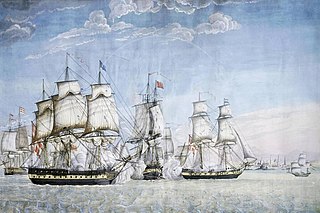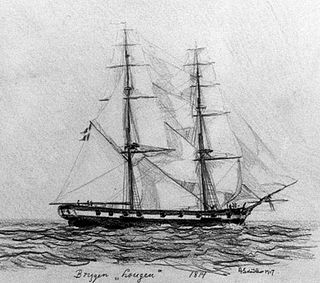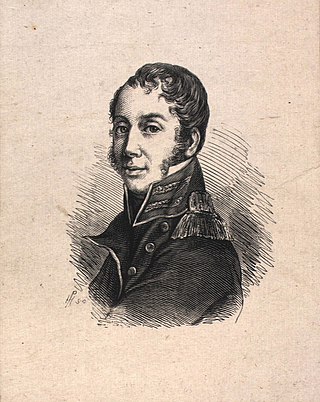
The Gunboat War was a naval conflict between Denmark–Norway and Great Britain supported by Sweden during the Napoleonic Wars. The war's name is derived from the Danish tactic of employing small gunboats against the materially superior Royal Navy. In Scandinavia it is seen as the later stage of the English Wars, whose commencement is accounted as the First Battle of Copenhagen in 1801.

HMS Tartar was a 32-gun fifth-rate Narcissus-class frigate of the Royal Navy, built at Frindsbury and launched in 1801. She captured privateers on the Jamaica station and fought in the Gunboat War and elsewhere in the Baltic Sea before being lost to grounding off Estonia in 1811.
HMS Algerine was a Pigmy–class 10-gun schooner of the Royal Navy. She was launched in March 1810. She served in the North Sea and then transferred to the West Indies, where she was wrecked in 1813.
Eight ships of the Royal Navy have borne the name HMS Seagull or HMS Sea Gull, after the gull:
HDMS Brev Drageren was a Danish let brigger, launched in 1801 for the Royal Danish Navy. She was one of the many vessels the British captured from the Danish after the Battle of Copenhagen in 1807. She was subsequently added to the Royal Navy as HMS Brev Drageren, and was involved in two notable actions while in British service. She was sold in 1825.
During the French Revolutionary and Napoleonic Wars the Admiralty also made use of hired armed vessels, one of which was His Majesty's Hired armed cutter Swan. Actually there were two such cutters, but the descriptions of these vessels and the dates of their service are such that they may well represent one vessel under successive contracts. The vessel or vessels cruised, blockaded, carried despatches and performed reconnaissance.

HDMS Sarpen was a brig of the Royal Dano-Norwegian Navy, in which she served from 1791 until the British seized her in 1807. While in Dano-Norwegian service she participated in an indecisive action at Tripoli, North Africa. She served the Royal Navy as HMS Sarpen from 1808 until 1811 when she was broken up. During her brief British service she participated in the Walcheren Expedition. Her name is that of a waterfall on the Norwegian river Glomma.

The Battle of Saltholm was fought on 9 June 1808 during the Gunboat War. Danish and Norwegian ships attacked a British convoy off the island of Saltholm in Øresund Strait near Copenhagen.

HDMS Lougen was a Danish naval brig launched in 1805. She saw service in the Danish navy and participated in two notable actions against the British Royal Navy during the Gunboat War. In 1814, as a result of the Treaty of Kiel, the Danes transferred her to the Norwegian navy. The Norwegians sold her to German merchants in the Scheld in 1825. She was finally shipwrecked near Bremerhaven in 1881.

Grinder was a gunboat serving as a tender, rather than a commissioned warship, to HMS Anholt, the British garrison on the island of Anholt during the Gunboat War. Grinder's origins are obscure, but the Danes captured her in 1810 and the British recaptured her in 1811. She was sold in 1832.
HMS Alban was one of twelve Adonis-class schooners of the Royal Navy and was launched in 1806. She served during the Napoleonic Wars. During the Gunboat War she took part in two engagements with Danish gunboats, during the second of which the Danes captured her. The British recaptured her seven months later, but she was wrecked in 1812.

HMS Piercer was a Royal Navy Archer-class gun-brig launched in 1804. She served against the French, Danes and Dutch in the Napoleonic Wars and was assigned to the Downs station. She participated in a number of operations in the Bay of Biscay, the English Channel, and the North Sea. In 1814 the British government transferred Piercer to the Kingdom of Hanover for use as a guard ship. Hanover decommissioned her in 1850.

Hans Peter Holm was a Danish naval officer who commanded vessels of the Dano-Norwegian Navy in several actions. He commanded several naval vessels during the Gunboat War. His most important action occurred in 1812 at the Battle of Lyngør when a British squadron, led by the British ship-of-the-line HMS Dictator, destroyed his vessel, HDMS Najaden. Holm sustained wounds in the battle but survived, only to drown in an accident shortly afterwards.
HDMS Lolland was launched in March 1810. She served in at least four major engagements during the Gunboat War before she was transferred to the Norwegian navy after the Treaty of Kiel brought about the separation of Norway from Denmark in 1814. Lolland continued to serve with the Norwegian Navy until sold in 1847.

HDMS Allart, a brig launched at Copenhagen in June 1807, was amongst the ships taken by the British after the second Battle of Copenhagen. In British service, she was recaptured by Danish-Norwegian gunboats after venturing too close inshore. Her subsequent service was in the Dano-Norwegian Navy's Norwegian Brig Division, which harried enemy frigates and convoys in Norwegian waters. In 1812, she was captained by Ulrich Anton Schønheyder. His father was after the mother's death married to Joachime Catharine Benzon (1757-1836). On the separation of Denmark from Norway in 1814, Allart transferred to the Norwegian navy, who sold her in 1825.
HMS Barbara was an Adonis class schooner of the Royal Navy and launched in 1806. A French privateer captured her in 1807 and she became the French privateer Pératy. The Royal Navy recaptured her in 1808. She was paid off in June 1814 and sold in February 1815.
HMS Redbreast was an Archer-class brig of the British Royal Navy. She captured some small merchant vessels and privateers. She also participated in two actions that would in 1847 earn her surviving crew members clasps to the Naval General service Medal (NGSM). The Navy transferred in 1816 to His Majesty's Customs. She was finally sold in 1850.
The following is a List of the Royal Dano-Norwegian naval order of battle in Norway in 1808 after the capture of the British brig Seagull on 19 June 1808.

HMS Daphne was launched at Topsham, England in 1806. During her naval career Daphne operated primarily in the Baltic where she took part in one notable cutting-out expedition, and captured one small privateer and numerous small Danish merchant vessels. In 1816 the Admiralty sold her after the end of the Napoleonic Wars and she became a merchant ship, while retaining the name Daphne. She made one voyage to Australia in 1819 transporting convicts. Thereafter she traded with India and was last listed in 1824.

HMS Tickler was launched in August 1808 at Brightlingsea as a later Archer-class gunbrig. She served in the Channel and the Baltic until the Danes captured her in 1808 during the Gunboat War. They sold her in 1815. From 1815 to 1852 she sailed as Frederikke Louise, first as a merchantman and then from 1843 to 1851 as a sealer.













